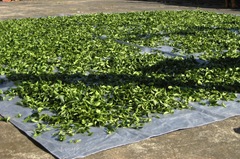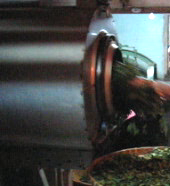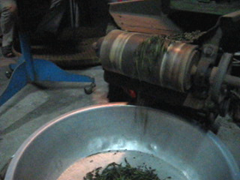The Dude rolls out of bed at dawn. He boils water to fill a pot of tea that he’s already brewed from for a few days; farmers don’t tend to waste anything. His wife’s been awake for nearly an hour and has made a simple breakfast of rice porridge and leftover chicken that is hearty and sustaining. She sets a serving in front of The Dude, grabs her sweatshirt and paddy hat off of the stool in the corner, and sets off to join the rest of the tea pickers in the field as they prepare for the morning harvest.
Meanwhile, The Dude finishes his meal and picks his teeth clean with his pinky nail. He meanders over to the courtyard where the tea pickers will offload their baskets of leaves and begins to sweep the cement floor with a straw broom, shooing away the dogs that lay there. A blue tarp is unfolded and placed in a corner of the courtyard, upon which leaves will later rest.

After a morning of picking, the workers gather for an early lunch. A pot of rice and some veggies & meat complete another hearty meal. Bones – even chicken bones – are thrown at the dogs that pace around, still eying their previous sleeping spots that are now covered with leaves. One dog scampers across the courtyard, running over the tea as he hurries to catch a food scrap.
After the tea is dried outside, it’s placed on racks inside to continue to oxidize/wither. Other batches of tea, some being made into cold brew or lightly-oxidized fragrant tea, are in various stages of being processed. A big, metal, cement-mixer like machine heats the leaves to 140 degrees+ celcius as it rolls around, its function to halt the oxidation of the leaves. A very green and raw scent lingers thickly in the air.

We test the tea that comes out of the cement mixer, just for fun. The Dude grabs a wet porcelain bowl and puts in a big pinch of steaming-hot tea leaves. The bowl is black wherever he touches it – extra flavoring from the broom dust/lunch/bug squashing…. The aroma is floral & fresh, the taste is raw & vegetal. I smile at The Dude and drink without hesitation – it’s good dirt in there, I tell myself.

We dump out the leaves from the oxidation-stopping machine and haul it over to a belt-driven drying machine, whose function is to remove the bulk of the moisture from the leaves. We dump the leaves into the top of it and wait as it dries the leaves and moves them out via a belt at the bottom of the machine.

The Dude reaches down and grabs a handful of hot, dry leaves that have accumulated in a pan. He fills a small bag and tells me to take it home to drink later. “Freeze it and brew it while still frozen – it’s very refreshing,” he instructs me before adding, “do you think it smells kind of like Marijuana?” Grateful, I take the bag from him whilst unable to stop staring at his hands, which show all the signs and by-products of the day’s labor. I’m surprised by his comment and can only muster a lame and nervous response of, “The tea smells good. Heh heh.” He carries on with ball-rolling the tea for later roasting.
I always rinse my tea leaves and offer up that first brew to the dirt from which it came.
Drink good tea and enrich your life.











